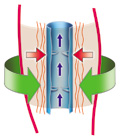Phlebological aspects |
||||
|
The cardiovascular system is made up of some hollow organs. |
|
|||
 |
 |
 |
||
the venous foot pump and the calf muscles |
when the muscles contract, they force the blood to flow upwards by compressing the deep veins |
the action of the venous valves prevents backflow |
||
From the anatomical point of view, the venous system of the lower limbs is made up of a superficial system and a deep system that communicate with one another. While walking, the spongy vascular tissue made up of capillaries situated at the base of the foot, compressed between the weight bearing base on one side and the bone base on the other, acts by pushing the blood towards the veins in the leg. As the leg muscles contract, they compress the deep veins, thus forcing the blood upwards (also through the action of valves that prevent backflow).
The venous system of the lower limbs is therefore characterized by a precarious and complex balance between hydrostatic pressure, concentration of the chemical substances present in the plasma and the tissues, the efficiency of the venous valve system, adequate plantar support and muscle tone.
Cizeta Medicali, a leader in the study of elastic compression on venous haemodynamics set up their Sports Division specifically to design Compression Zone®, a line of high-technology products which, on the basis of sophisticated wearability tables, provide perfect elastic compression on the legs of each individual athlete.
In addition, through its technologically advanced components such as antiseptic and heat dissipating yarns, Compression Zone® ensures greater hygiene and complete evaporation of sweat.
Compression Zone® improves cardiocirculatory function (the increase in venous return increases cardiac volume so that the heart rate is lower at the same cardiac output and the output is higher at the maximum heart rate) and also acts on the metabolism by optimizing the transport of nutrients to the muscle and increasing its efficiency (transport of nutrients to the muscle cells).
Both these conditions are crucial factors in optimizing performance.
Compression Zone®:
increases cardiocirculatory efficiency
reduces the increase in heart rate
increases maximal work (muscular power)
optimizes muscle metabolism






